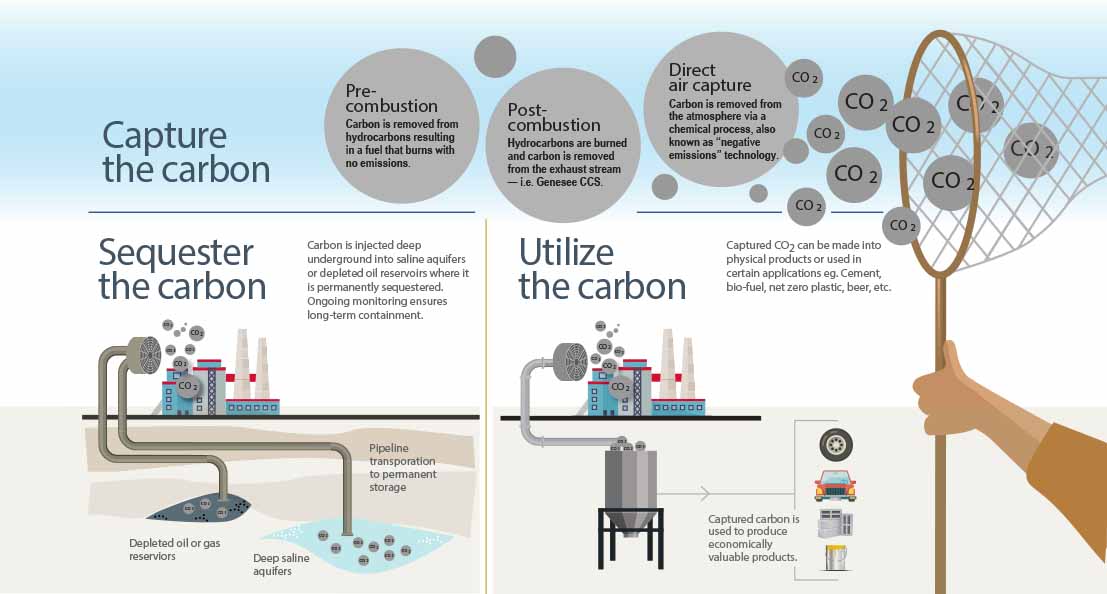Advancing a net zero future
We’re committed to doing our part in the transition to a net zero energy future. That’s why we’re proud to support and advance the commercialization of carbon capture, utilization and sequestration (CCUS) technology and plan to integrate direct air capture (DAC) into our portfolio of decarbonization technologies to further reduce emissions.
We recognize CCUS as an integral part of the long-term solution to tackle climate change globally and enable zero or near-zero emissions from natural gas generation. When combined with the integration of renewables, CCUS will ensure the ongoing affordability and reliability of our power systems while critically reducing emissions. The addition of DAC technology further supports our decarbonization goals by offering the potential to physically offset emissions from our portfolio that are not technically or economically feasible to eliminate at source.
To support our efforts to advance the development and commercialization of CCUS technology, we’re participating in the Carbon Capture Coalition and Canadian Carbon Capture Collaborative.

Genesee CCS Project
Capital Power is discontinuing pursuit of the Genesee CCS project. Through our development of the project, we have confirmed that CCS is a technically viable technology and potential pathway to decarbonization for thermal generation facilities including the Genesee Generating Station. However, at this time, the project is not economically feasible and as a result we will be turning our time, attention, and resources to other opportunities to serve our customers with balanced energy solutions. Capital Power looks forward to exploring CCS at Genesee and the rest of our North American fleet in the future as economics improve.
Direct Air Capture
We believe a combination of technologies will be necessary to achieve our goal of being net zero by 2045. DAC is a promising technology that will support our decarbonization efforts by physically reducing emissions across our portfolio. DAC complements the other technologies in our portfolio and offers the potential to reduce emissions from our facilities that may otherwise have limited opportunities for decarbonization due to technical or economic limitations.
Genesee Carbon Conversion Centre (GC3)
Capital Power is proceeding with plans to build the world’s largest commercial scale production facility of carbon nanotubes (CNTs) at our Genesee Generating Station. The project received Alberta Utilities Commission approval on June 18, 2021 and is also a recipient of Emissions Reduction Alberta funding through their Shovel-Ready Challenge. The design phase of GC3 is underway. The project will have an initial production capacity of 2,500 tonnes of CNTs per year and once completed will be capable of producing up to 7,500 tonnes annually. GC3 will deploy C2CNT technology – a carbon utilization solution that transforms emissions into high quality carbon nanotubes. Capital Power is a 40% equity owner in C2CNT LLC.
Hydrogen
In 2023, we were selected as recipients of Ontario Energy’s Hydrogen Innovation Fund, which paves the way for the production of reliable, affordable and clean electricity from hydrogen to help power the province’s growth.
At our Goreway Power Station, East Windsor Cogeneration Centre, and York Energy Centre, we’re exploring hydrogen blending using various mixes of hydrogen (from 5% to 15%). Engineering studies will be conducted at each site to evaluate the impacts on the natural gas turbine’s performance, maintenance, operability, emissions, and safety considerations, as well as how hydrogen could be procured, transported, and stored.
At Kingsbridge, we’re exploring the economic and technical feasibility of creating green hydrogen from wind and storing it underground in depleted gas reservoirs.